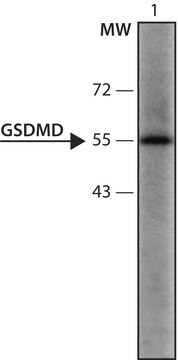MABT398
Anti-CD226/DNAM-1 Antibody, clone LeoA1 (Azide Free)
clone LeoA1, from mouse
Synonym(e):
CD226 antigen, DNAX accessory molecule 1, DNAM-1, CD_antigen=CD226
About This Item
Empfohlene Produkte
Biologische Quelle
mouse
Qualitätsniveau
Antikörperform
purified antibody
Antikörper-Produkttyp
primary antibodies
Klon
LeoA1, monoclonal
Speziesreaktivität
human
Methode(n)
activity assay: suitable
flow cytometry: suitable
immunocytochemistry: suitable
immunoprecipitation (IP): suitable
inhibition assay: suitable
western blot: suitable
Isotyp
IgG1κ
NCBI-Hinterlegungsnummer
UniProt-Hinterlegungsnummer
Versandbedingung
dry ice
Posttranslationale Modifikation Target
unmodified
Angaben zum Gen
human ... CD226(10666)
Allgemeine Beschreibung
Spezifität
Immunogen
Anwendung
Zellstruktur
Adhäsions-Proteine (CAMs – Zelladhäsionsmoleküle)
Flow Cytometry Analysis: 1.0 µg of this antibody from a representative lot detected CD226/DNAM-1 in 1X10E6 CD226 transfected CHO cells.
Activity Assay Analysis: A representative lot detected CD226/DNAM-1 which induces platelet aggregation (Scott, J.L., et al. (1989). Journal of Biol. Chem. 264(23):13475-13482).
Competative Binding Assay Analysis: A representative lot detected CD226/DNAM-1 in the binding of this antibody to resting and pharmacologically activated PHA-induced blasts and Jurkat cells (Sherrington, P.D., et al. (1997). Journal of Biol. Chem. 272:21735-21744).
Inhibition Assay Analysis: A representative lot detected CD226/DNAM-1 which inhibited the induction of both CTL andAK cells from their precursors (Burns, G.F., et al. (1985). J. Exp. Med. 161:1063-1078).
Immunoprecipitation Analysis: A representative lot detected CD226/DNAM-1 in MLA-I44 cells (Burns, G.F., et al. (1985). J. Exp. Med. 161:1063-1078).
Immunoprecipitation Analysis: A representative lot detected CD226/DNAM-1 in Jurkat PTA-1 transfectants stimulated with TPA (Ralston, K.J., et al. (2004). Journal of Biol. Chem. 279:33816-33828).
Qualität
Western Blotting Analysis: 0.5 µg/mL of this antibody detected CD226/DNAM-1 in 10 µg of CD226 transfected CHO cell lysate.
Zielbeschreibung
Physikalische Form
Lagerung und Haltbarkeit
Handling Recommendations: Upon receipt and prior to removing the cap, centrifuge the vial and gently mix the solution. Aliquot into microcentrifuge tubes and store at -20°C. Avoid repeated freeze/thaw cycles, which may damage IgG and affect product performance.
Sonstige Hinweise
Haftungsausschluss
Sie haben nicht das passende Produkt gefunden?
Probieren Sie unser Produkt-Auswahlhilfe. aus.
Lagerklassenschlüssel
12 - Non Combustible Liquids
WGK
WGK 2
Flammpunkt (°F)
Not applicable
Flammpunkt (°C)
Not applicable
Analysenzertifikate (COA)
Suchen Sie nach Analysenzertifikate (COA), indem Sie die Lot-/Chargennummer des Produkts eingeben. Lot- und Chargennummern sind auf dem Produktetikett hinter den Wörtern ‘Lot’ oder ‘Batch’ (Lot oder Charge) zu finden.
Besitzen Sie dieses Produkt bereits?
In der Dokumentenbibliothek finden Sie die Dokumentation zu den Produkten, die Sie kürzlich erworben haben.
Unser Team von Wissenschaftlern verfügt über Erfahrung in allen Forschungsbereichen einschließlich Life Science, Materialwissenschaften, chemischer Synthese, Chromatographie, Analytik und vielen mehr..
Setzen Sie sich mit dem technischen Dienst in Verbindung.








